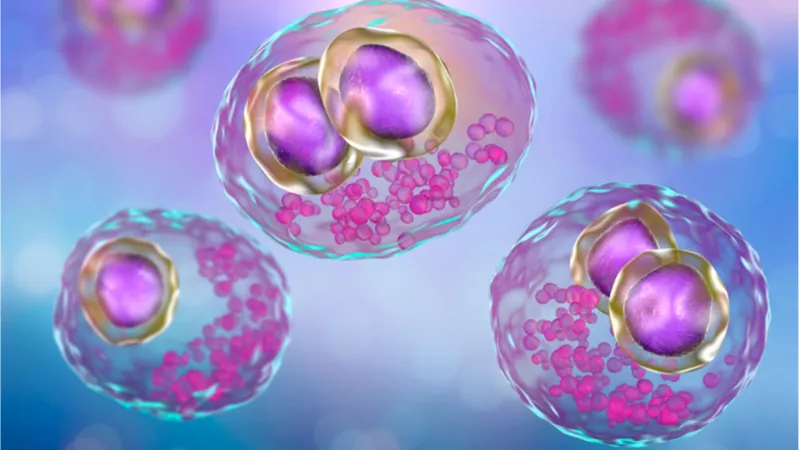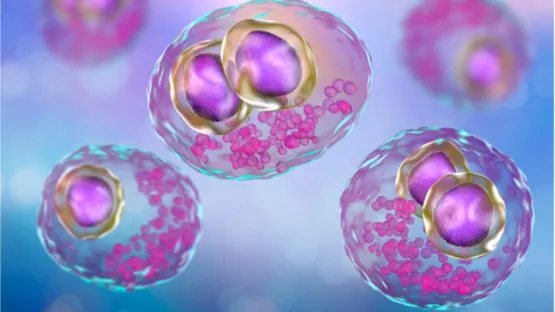Today, we want to highlight a new publication that looks at cytomegalovirus (CMV) and its potential role in the development of metabolic syndrome.
What is cytomegalovirus?
CMV is part of the β-subfamily of herpes viruses, a family of viruses that are believed to have been co-evolving with their hosts for around 180 million years [1]. CMV is spread primarily by exposure to infected secretions and subsequent mucosal contact, which then leads to the acute infection of various cell types. After this acute infection, in which the virus spreads, it enters a dormant state in the body.
In the United States, around one in three children are believed to be infected with CMV by the age of five. More than fifty percent of adults by the age of 40 are thought to be infected with CMV. CMV is a persistent virus; once it enters a person’s body, it stays there for life.
CMV infection is asymptomatic, meaning that it is latent and produces no symptoms; lying dormant in the cell, it waits for activation under certain set conditions [2].
Reactivation from this dormant state is believed to happen periodically, so it requires constant, lifelong immune surveillance to keep the body free from disease. Patients who have compromised immune systems are at greater risk for CMV reactivation, and this can lead to an increase of morbidity and mortality [3].
The need for lifelong immune surveillance to keep CMV in check puts a drain on the immune system as a whole, as ever-greater numbers of immune cells have to specialize in countering the virus. This draws off valuable immune cells, which could otherwise be fighting different pathogens, and contributes to the weakening of the immune system. This, combined with an ever-declining supply of fresh immune cells produced by sources such as the thymus and hematopoietic stem cells, ultimately results in the weakening of the immune system, greatly reducing its ability to react to threats.
In order to reactive and awaken from this dormant state, CMV, like all herpesviruses, progresses through an ordered cascade that starts with the expression of intermediate-early genes, which serve as a trigger for further (early and late) viral gene expression [4]. Studies have shown that CMV periodically expresses these intermediate-early genes at random during this dormant (latent) period [5-6]. This means that there is always a background level of CMV reactivation.
Once these initial genes are expressed, the cycle moves to express genes for host manipulation, DNA replication, and viral packaging. The expression of the intermediate-early genes is closely linked to pro-inflammatory transcription factors, such as nuclear factor kappa beta (NF-κB), TNFα, and interleukin-1β. Not surprisingly, these inflammatory signals can reactivate CMV as a result of this link [7-8].
In this way, CMV actively responds to its environment, and its behavior is dictated by the local inflammatory situation. Essentially, this means that injuries and any other sources of inflammation could awaken CMV from its dormant state just by the presence of inflammatory signals, and it uses this inflammation as a way to increasingly reproduce and spread throughout the body.
CMV and metabolic syndrome
Deregulated nutrient sensing is one of the hallmarks of aging, and metabolic syndrome is a part of this process as well as being a possible precursor to type 2 diabetes. Factors such as being sedentary or overweight can provoke metabolic syndrome to develop, particularly when excessive amounts of visceral fat are present. Being overweight when older is particularly problematic and is linked to senescent cell accumulation, another cause of aging, and systemic inflammation [9].
A new study explores the relationship between CMV infection, fat tissue, and the development of metabolic syndrome [10].
Cytomegalovirus (CMV) is a ubiquitous herpesvirus infecting most of the world’s population. CMV has been rigorously investigated for its impact on lifelong immunity and potential complications arising from lifelong infection. A rigorous adaptive immune response mounts during progression of CMV infection from acute to latent states. CD8 T cells, in large part, drive this response and have very clearly been demonstrated to take up residence in the salivary gland and lungs of infected mice during latency. However, the role of tissue resident CD8 T cells as an ongoing defense mechanism against CMV has not been studied in other anatomical locations. Therefore, we sought to identify additional locations of anti-CMV T cell residency and the physiological consequences of such a response. Through RT-qPCR we found that mouse CMV (mCMV) infected the visceral adipose tissue and that this resulted in an expansion of leukocytes in situ. We further found, through flow cytometry, that adipose tissue became enriched in cytotoxic CD8 T cells that are specific for mCMV antigens from day 7 post infection through the lifespan of an infected animal (> 450 days post infection) and that carry markers of tissue residence. Furthermore, we found that inflammatory cytokines are elevated alongside the expansion of CD8 T cells. Finally, we show a correlation between the inflammatory state of adipose tissue in response to mCMV infection and the development of hyperglycemia in mice. Overall, this study identifies adipose tissue as a location of viral infection leading to a sustained and lifelong adaptive immune response mediated by CD8 T cells that correlates with hyperglycemia. These data potentially provide a mechanistic link between metabolic syndrome and chronic infection.
Conclusion
This is yet more support for regular exercise and a balanced diet in order to avoid weight gain and the formation of an excessive amount of visceral fat.
Literature
[1] McGeoch, D. J., Cook, S., Dolan, A., Jamieson, F. E., & Telford, E. A. (1995). Molecular phylogeny and evolutionary timescale for the family of mammalian herpesviruses. Journal of molecular biology, 247(3), 443-458.
[2] Fields, B. N., Knipe, D. M., Howley, P. M., & Griffin, D. E. (2007). Fields virology. 5th.
[3] Crough, T., & Khanna, R. (2009). Immunobiology of human cytomegalovirus: from bench to bedside. Clinical microbiology reviews, 22(1), 76-98.
[4] Hermiston, T. W., Malone, C. L., Witte, P. R., & Stinski, M. F. (1987). Identification and characterization of the human cytomegalovirus immediate-early region 2 gene that stimulates gene expression from an inducible promoter. Journal of Virology, 61(10), 3214-3221.
[[5] Grzimek, N. K., Dreis, D., Schmalz, S., & Reddehase, M. J. (2001). Random, Asynchronous, and Asymmetric Transcriptional Activity of Enhancer-Flanking Major Immediate-Early Genes ie1/3 andie2 during Murine Cytomegalovirus Latency in the Lungs. Journal of Virology, 75(6), 2692-2705.
[6] Henry, S. C., & Hamilton, J. D. (1993). Detection of murine cytomegalovirus immediate early 1 transcripts in the spleens of latently infected mice. Journal of Infectious Diseases, 167(4), 950-954.
[7] Hummel, M., Zhang, Z., Yan, S., DePlaen, I., Golia, P., Varghese, T., … & Abecassis, M. I. (2001). Allogeneic transplantation induces expression of cytomegalovirus immediate-early genes in vivo: a model for reactivation from latency. Journal of Virology, 75(10), 4814-4822.
[8] Cook, C. H., Trgovcich, J., Zimmerman, P. D., Zhang, Y., & Sedmak, D. D. (2006). Lipopolysaccharide, tumor necrosis factor alpha, or interleukin-1β triggers reactivation of latent cytomegalovirus in immunocompetent mice. Journal of virology, 80(18), 9151-9158.
[9] List, E. O., Jensen, E., Kowalski, J., Buchman, M., Berryman, D. E., & Kopchick, J. J. (2016). Diet-induced weight loss is sufficient to reduce senescent cell number in white adipose tissue of weight-cycled mice. Nutrition and healthy aging, 4(1), 95-99.
[10] Contreras, N. A., Sitnik, K. M., Jeftic, I., Coplen, C. P., Čičin-Šain, L., & Nikolich-Žugich, J. (2019). Life-long control of cytomegalovirus (CMV) by T resident memory cells in the adipose tissue results in inflammation and hyperglycemia. PLoS pathogens, 15(6), e1007890.




